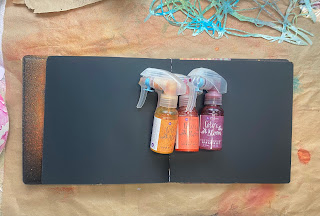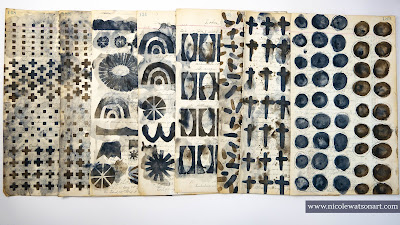StencilGirl® Talk
A blog for the StencilGirl® Product line owned by Mary Beth Shaw for people who love stencils like we love stencils.
Friday, April 4, 2025
Cry Wolf Canvas - by Claudia Neubacher
Friday, March 28, 2025
How to Create Stunning Layered Effects with Stencils and Masks on Black Paper
In this tutorial, I’ll walk you through my step-by-step process for creating depth, dimension, and rich, layered effects with stencils on black paper. Then, you’ll see how I bring a steampunk bird to life with Color Bloom Sprays, Pan Pastels, mica powders, and embossing ink.
If you’ve ever felt frustrated while stenciling with mixed media, this method will change the way you create.
Let’s dive in!
Step 1: Creating a Dynamic Background with Color Bloom Sprays
I started with a black paper journal and my Color Bloom Sprays. These sprays are fantastic for building vibrant layers, especially on dark surfaces. I randomly sprayed three different colors, letting them overlap and blend naturally.
Don't stress about placement—just let yourself play! The organic blending creates the magic.
Once the page was fully covered, I dried the sprays with a heat tool. You can also let them air dry, but the heat tool helps move the colors around, creating unique textures.
Step 2: Layering with Pan Pastels for Depth
Next, I grabbed the Open Bare Wisteria Vine Mask and my Pan Pastels in magenta, gold, and a deep orange shade. These colors show up beautifully against the metallic spray background.
Using a makeup sponge, I carefully pressed the pastel through my stencil while holding it in place to prevent shifting. This step is where the real depth and texture begin to build.
Turn your stencil as you go to avoid a repetitive pattern. This creates a more organic look.
I kept layering and experimenting with color until I achieved a bold, dimensional effect.
Step 3: Adding a Steampunk Bird and Stencil Detail with Mica Powder
For the focal point, I used a fussy-cut steampunk bird printable.
Using Versamark embossing ink, I sponged the ink through the Circle Rays 6 Stencil, then brushed on mica powder for a brilliant metallic shine.
Mica powder sticks beautifully to embossing ink! This step adds a luminous glow that makes the design pop.
Step 4: Adding a Poem and Finishing Touches
To complete the spread, I created a small poem and printed it out. Once cut into strips, I auditioned different placements before gluing them down.
If you print text from your computer, it may look too stark against your page. To blend the poem into the design, I used Fossilized Amber Distress Ink with a small brush to tint the edges of the text strips.
Final Thoughts
This project was so much fun and an easy way to explore layering with multiple mediums. If you’ve been hesitant to experiment with stencils, mica powders, and pastels, I hope this inspires you to try them in your next spread!
Stencils Used:
Key Takeaways from this Tutorial:
✔️ Use Color Bloom Sprays to create a vibrant base on black paper
✔️ Layer Pan Pastels through stencils for rich texture and depth
✔️ Mica powder + embossing ink = a luminous metallic shine
✔️ Blend printed text into your page with Distress Inks
Where to Find Me:
📌 Website: janebellanteart.com
📌 Instagram: @janebellanteart1
📌 Facebook: @janebellanteart
Let me know in the comments—what’s your favorite way to layer mixed media in your art journal?
Happy creating!
Jane Bellante
Friday, March 21, 2025
Creating More Stenciled Grungy Papers!
Hello Friends! Nicole back with another grungy paper tutorial, this one a bit bittersweet.
After three incredible years with the Creative Team, this is my final post. It has been a true honor to do what I love for StencilGirl®! I have met so many of YOU creatives who also love stencils, and there is nothing better than inspiring you to create and use those stencils!
This is not a forever goodbye. I'm looking forward to focussing my time on designing more stencils for StencilGirl® and sharing my creations, as always, over on Instagram and my YouTube channel. And, you never know when I might make a surprise appearance here!
With that, I wanted to leave you with one more grungy paper tutorial! I gathered a handful of 9x12 stencils that I haven't had a chance to play with along with my favorite Payne's gray and just played.
And, oh how I needed to play!

To begin, I always lightly gesso my papers. This helps add some integrity to older papers and allows the paint and water to move more easily on the page.
The process is quick, and it doesn't matter if entire page is perfectly covered. My process varies each time, but this session I was using up some gesso that I had turned over like ketchup to get the last bits out! I sprayed my papers with water and added gesso with my brush.
I’m using papers from an old ledger, but any papers will work! Old book pages are fun, too. Just make sure they aren't too thin and brittle. Ledgers aren’t always easy to find, so if you want to add that fun handwriting layer, you could always stamp or scribble all over paper before stenciling.
Creating the Papers
Once all the gessoed pages were dry, I started making my papers. The general process is the same each time, but I find that often I get a little more creative and adventurous as the playtime goes on. Oftentimes, I don't want to stop!
I simply use an applicator with paint through the stencil. Then, I add water + watered down paint and scruff up the stenciled image to distress it.
One thing I always keep in mind, is that I'm creating moments. It's not important to me that the entire paper is a work of art! I like to have variations on each page that I can use in different ways as needed for collage, backgrounds, journals, and more.
My first couple papers were simple, and then I changed it up a bit.
For this one, I tried to create an ombre effect, keeping the paint darker to the left and fading it to the right. When I was done stenciling, I added quite a bit of watered down paint to the left side and tilted the paper for drips.
I just used Payne's gray in the cross-like shapes and added watered-down raw umber with it. I liked stenciling it in two different directions for completely different looks.
Phew! That was a lot of amazing playtime, and I did not want to stop! I had so much fun making these papers and discovering amazing shapes and patterns in these stencils.
You can watch the grungy paper play in action in the video below:
Links to my other grungy paper/technique tutorials:
Thank You!
As I close out this blog and season, I just wanted to take a quick moment to thank you for all your kindness. I also want to thank the team at StencilGirl® for this amazing opportunity. It has been such a fun few years playing with these stencils.
I hope you create some grungy papers soon!
-Nicole
Connect with me on
























































